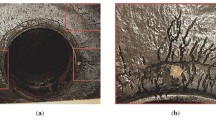Abstract
We analyze the characteristics of acoustic emission (AE) observed in the process of mechanical testing of hydrogenated and hydrogen-free specimens of thermal power equipment in uniaxial tension and three-point bending. It is shown that, in both cases, AE signals in hydrogenated specimens appear at earlier stages of loading than in hydrogen-free specimens. We suggest the use of this phenomenon in detecting hydrogen-induced damage to steel. It is discovered that the deposition of scale on the surface of pipes makes the interpretation of received AE information much more complicated.
Similar content being viewed by others
References
A. B. Vainman, R. K. Melekhov, and O. D. Smiyan,Hydrogen Embrittlement of Members of High-Pressure Boilers [in Russian], Naukova Dumka, Kiev (1990).
A. E. Andreikiv and M. V. Lysak,Investigation of Fracture Processes by the Method of Acoustic Emission [in Russian], Naukova Dumka, Kiev (1989).
M. V. Lysak, V. R. Skal's'kyi, Ya. L. Ivanyts'kyi, S. E. Kovchyk, and O. M. Serhienko, “Application of the method of acoustic emission to the investigation of crack initiation under protective fused coatings of reactor vessels”,Fiz.-Khim. Mekh. Mater. 25, No. 2, 79–81 (1989).
A. E. Andreikiv, M. V. Lysak, V. R. Skal's'kyi, and O. M. Serhienko,Methodological Aspects of the Application of the Acoustic-Emission Method to the Determination of the Static Crack Resistance of Materials [in Russian], Preprint No. 165, Karpenko Physicomechanical Institute, Ukrainian Academy of Sciences, L'viv (1990).
M. E. M. Koch,Untersuchung zum Einfluss Gefüge und Oberflächenzustands auf die Wasserstoffersrödung von Stählen unter Einbeziehung der Schallemissionsanalyse, Diss. Dokt. Ing. Fak. Maschinener Techn., Univ. München (1986).
Kh. G. Schnitt-Thomas and W. Stengel, “Möglichkeiten zur Früherkennung von Wasserstoffschädigungen in metallischen Werkstoffen durch Anwendung der Schallemissionsanalyse,”Werkstoffe Korrosion 34, 7–13 (1983).
GOST 25.506-85 (Introduced 01.01.86).Methods for Mechanical Testing of Metals. Determination of the Characteristics of Crack-Growth Resistance (Fracture Toughness) under Static Loading, Izd. Standartov, Moscow (1985).
Additional information
Karpenko Physicomechanical Institute, Ukrainian Academy of Sciences, L'viv. Translated from Fiziko-Khimicheskaya Mekhanika Materialov, Vol. 30, No. 4, pp. 90–96, July – August, 1994.
Rights and permissions
About this article
Cite this article
Skal's'kyi, V.R., Lysak, M.V. & Vainman, A.B. Acoustic-emission method for detection of hydrogen-induced damage to steels of high-pressure boilers of thermal power plants under static loading. Mater Sci 30, 484–490 (1995). https://doi.org/10.1007/BF00558843
Received:
Issue Date:
DOI: https://doi.org/10.1007/BF00558843



